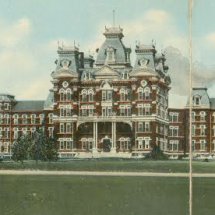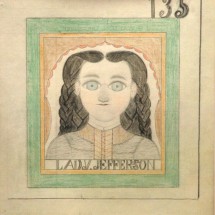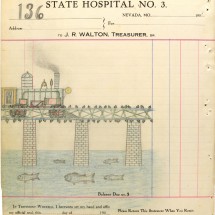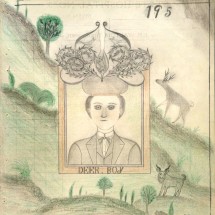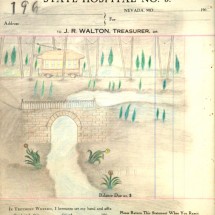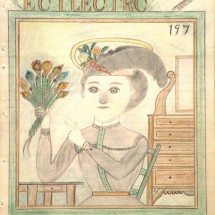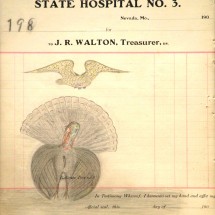James Edward Deeds, Jr. [aka The Electric Pencil] (American, b. Panama 1908–1987)
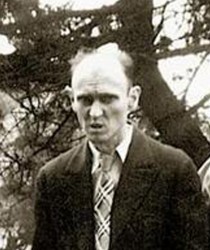
1944, at State Hospital No. 3
Edward Deeds was born the oldest of five children in Panama where his father served in the military. When he was four years old, his family moved to the family homestead in Missouri where they settled as farmers. Accounts paint Edward as a well-meaning but troubled youth with difficulty adjusting socially. His situation worsened and eventually erupted in a threat of violence that prompted his father to seek hospitalization for his son. He was diagnosed with schizophrenia and in 1936 he was committed to a sprawling mental hospital in Nevada, Missouri, where he lived for thirty-seven years. Around 1970, a fourteen-year-old boy named Reid Henderson found a small, hand-sewn album of 283 drawings from a pile of trash on the curb. In 2006, he relinquished them to a bookseller and the drawings emerged into the world of collectors and spurred a search for the artist’s identity. Gradually it was discovered that the book was made by Deeds while institutionalized and later given as a gift to his mother who in turn gave it to Edward’s brother Clay for safekeeping. While relocating, Clay accidently misplaced them and they were discarded on the street as valueless.
Deed’s drawings are all made on two-sided ledger paper from the state hospital where he lived. His subjects included portraits, railroads, nautical scenes, landscapes, animals, circuses, and maps. Stylized in a manner similar to 19th-century prints but also common to vernacular paintings of the times, his portraits are variations on a theme. He methodically rendered his figures with high foreheads, wide staring eyes, and button mouths on both women and men. While he most likely used newspaper and magazine images as sources, his style ranges from realistically observed to improvisational. The rigid intricacy he employed in rendering architecture differs greatly from the delicate, fluid line used in depicting hair and feathers that adorn women’s hats. While he may have had particular models in mind, the works are clearly inspired by his imagination. It is reasonable to assume that drawing was a therapeutic escape for him and it has been suggested that some of his depictions of vintage costumes and old-fashioned cars and boats might be expressions of nostalgia for an earlier era.
- Missouri State Hospital Number 3
- “Lady Jefferson” / Trestle Bridge with Locomotive [135/136], ca. 1936-66 (front of sheet)
- “Lady Jefferson” / Trestle Bridge with Locomotive [135/136], ca. 1936-66 (back of sheet)
- “Deer Boy” / Landscape with Bridge and Train Car [195 / 196], ca. 1936-66 (front of sheet)
- “Deer Boy” / Landscape with Bridge and Train Car [195 / 196], ca. 1936-66 (back of sheet)
- “Ectlectric Pencil” [197 / 198], ca. 1936-66 (front of sheet)
- “Ectlectric Pencil” [197 / 198], ca. 1936-66 (back of sheet)

